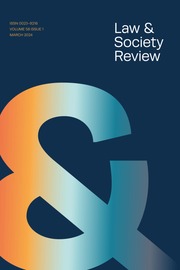Article contents
Even Lawyers Get the Blues: Gender, Depression, and Job Satisfaction in Legal Practice
Published online by Cambridge University Press: 01 January 2024
Abstract
It is an intriguing puzzle that women lawyers, despite less desirable working conditions and blocked career advancement, report similar satisfaction as men lawyers with their legal careers. The paradoxical work satisfaction reported by women and men lawyers obscures a more notable difference in their depressed or despondent feelings. Using a panel study of women and men lawyers practicing in Toronto since the mid-1980s, we find at least three causal pathways through which gender indirectly is connected to job dissatisfaction and feelings of despondency. The first path is through gender differences in occupational power, which lead to differential despondency. The second path is through differences in perceived powerlessness, which directly influence job dissatisfaction. The third path is through feelings of despondency that result from concerns about the career consequences of having children. The combined picture that results illustrates the necessity to include measures of depressed affect in studies of dissatisfaction with legal practice. Explicit measurement and modeling of concerns about the consequences of having children and depressed feelings reveal a highly gendered response of women to legal practice that is otherwise much less apparent. Women are more likely to respond to their professional grievances with internalized feelings of despondency than with externalized expressions of job dissatisfaction. That is, they are more likely to privatize than publicize their professional troubles.
- Type
- A Serendipitous Symposium: Two Issues Confronting the Legal Profession
- Information
- Copyright
- © 2007 Law and Society Association.
Footnotes
This research was supported by grants from the Social Sciences and Humanities Research Council of Canada and the American Bar Foundation and was made possible by the cooperation and assistance of the Law Society of Upper Canada. The views expressed in this article are those of the authors and do not necessarily reflect the views of the Law Society of Upper Canada. We thank Tara Carnochan for valuable research assistance.
References
- 44
- Cited by


